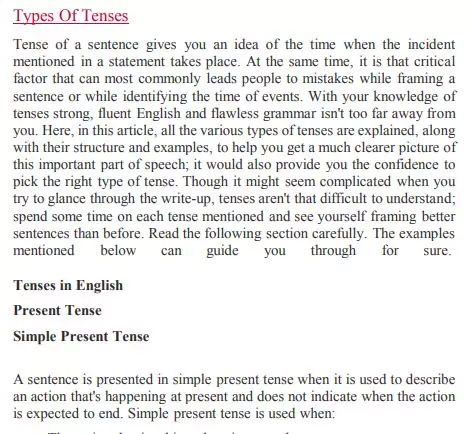‘Types Of Tenses’ PDF Quick download link is given at the bottom of this article. You can see the PDF demo, size of the PDF, page numbers, and direct download Free PDF of ‘Tenses Exercises’ using the download button.
Assignment Of Tenses Book PDF Free Download

Tenses Assignment
The tense of a sentence gives you an idea of the time when the incident mentioned in a statement takes place.
At the same time, it is that critical factor that can most commonly lead people to mistakes while framing a sentence or while identifying the time of events.
With your knowledge of tenses strong, fluent English and flawless grammar aren’t too far away from you.
Here, in this article, all the various types of tenses are explained, along with their structure and examples, to help you get a much clearer picture of this important part of speech; it would also provide you with the confidence to pick the right type of tense.
Though it might seem complicated when you try to glance through the write-up, tenses aren’t that difficult to understand; spend some time on each tense mentioned and see yourself framing better sentences than before. Read the following section carefully.
The examples mentioned below can guide you through for sure.
Tenses in English Present Tense
Simple Present Tense
A sentence is presented in simple present tense when it is used to describe an action that’s happening at present and does not indicate when the action is expected to end.
The simple present tense is used when:
The action that is taking place in general.
The action is not only occurring now; it repeats after regular intervals of time.
To indicate facts that are generally true.
The action for relating habits and routines that happen all the time, be it in the future, past or present.
The verb “+s/es” form is used;
If the subject is 3rd person singular. The verb is used in its original form;
If the subject is 1st and/or 2nd person singular.
If the subject is 1st and/or 2nd person plural.
If the subject is 3rd person plural.
Some Examples:
The sun sets in the west.
All the cars stop at this crossing.
Michael teaches social studies in a school.
That notice reads, “No parking”.
Rajdhani leaves at seven in the morning.
The teacher said if she works hard she will pass.
There goes the taxi.
Do you play tennis?
He does not go to the temple.
Does he write novels?
Present Progressive Or Present Continuous Though the simple present and present continuous tenses are used interchangeably, present continuous usually defines an act that is going on
at the time of speaking.
The sentences with present progressive tense are used when:
Something is taking place now while speaking and has a definite end as well.
When something is already decided and arranged as well to perform it.
To indicate an undesirable habit.
Structure:
Use the first form of the verb “+ing”
Singular 3rd person subject — use ‘is’
Plural 1st, 2nd and 3rd person and singular 2nd person subject — use ‘are’
1st person singular — use ‘am’
In other words, it is “Subject + be (is, am, are) + Verb+ -ing + Object”
Some Examples:
Please wait for a moment, Shyam is talking to Mary.
We are late; he will be waiting for us at the restaurant now.
Mom, I am playing football.
Are they still living here?
She is having her breakfast now.
I’m planning to meet the Director tonight.
Present Perfect Tense
It’s probably the most used tense form in English Grammar and is also considered difficult to understand. The Present Perfect Tense explains the incident that has happened in the past and that continues until the present time.
Examples
For almost five generations, my family members have been engineers.
In order to avoid delays in my work, I have been doing it regularly.
I have always wanted to ride in this vehicle. Present Perfect Continuous Tense Usually, Present Perfect Continuous Tense is used for a situation that has occurred in the past and which continues until that moment.
Structure:
Use the first form of the verb + “–ing”
Singular subject (has been), Plural subject, or I (have been)
‘Since’— if the point of time is mentioned.
‘For’ — if the duration of time is specified.
Examples:
I have been eating apples today.
You have not been studying for the past month.
We haven’t been playing with Mary since Tuesday
| Author | – |
| Language | English |
| No. of Pages | 7 |
| PDF Size | 1 MB |
| Category | Grammar |
| Source/Credits | uobabylon.edu.iq |
Related PDFs
Assignment Of Tenses Book PDF Free Download
